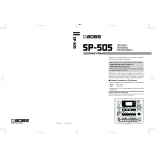TR-REC
(Step Recording)
In this method
of
recording, you create a pattern by specifying the steps at which each instrument will sound.
This
will modify the pattern that
is
selected.
You
can
even play back the pattern while you'
re
creating it.
1. Press
the
[TR-REC]
button
(0)
.
2.
Use
the
variation
buttons
to
select
either
A
or
B.
*
If
A and B are playing consecutively, you can hold
down
[A]
and
press
[B]
to
select
A,
or hold down
[B]
and
press
[A]
to
select B.
*
By
holding
down
the
[TR
-
REC
]
button
and pressing
[A]
or
[BJ.
you
can
edit the pattern
of
the specified variation
regardless
of
the pattern that's currently playing.
3.
Use
the
[SCALE]
button
(6))
to
specify
the
scale.
4. Press
one
of
the
INST select
buttons
(G)
to
select
the
instrument
that
you
want
to
record.
5.
Use
the
pads
(m)
to
specify
the
steps
at
which you
want
the
selected
instrument
to
sound.
6. Repeat steps
3-4.
Specifying
the
length
of
the
pattern (LAST
STEP)
•••••••••••••••••••••••••••••••••••
Here's
how
to
specify the number
of
steps
that
the pattern
will contain.
1.
Hold
down
the
[LAST
STEP]
button
(0)
and press a
pad
(m)
to
specify
the
last step.
*
You
can
't specify
LAST
STEP
if
multiple patterns
are
selected.
Specifying accents
•••••••••••••••••••••••••••••••••••
1.
Press
the
[STEP]
button
(8).
2. Press
the
pads
(m)
for
each step
at
which you
want
to
add
an accent.
3.
Use
the
[LEVEl]
knob
(8)
to
adjust
the
volume
of
the
accent.
Applying reverb or delay
•••••••••••••••••••••••••••••••••••
1. Press
the
[STEP]
button
(00)
.
2.
Use
the
pads
(m)
to
specify
the
steps
at
which
you
want
to
apply
reverb
or
delay.
3.
Use
the
knobs such
as
[LEVEL]
and
[TIME]
(00)
to
adjust
the
parameters.
Deleting a recorded instrument from
the
pattern
•••••••••••••••••••••••••••••••••••
..
Refer
to
"INST-REC (Realtime
Recording)"
Playing alternate sounds or weak beats
•
••••••••••••••••••••••••••••••••••
The following sounds allow you
to
play alternate sounds. For
the other sounds, you can specify weak beats.
707
B01l2
,
707
RS
/Cowbell,
727 H/L Bongo,
727 H/L Agogo,
707501/2,
707 HCITambourine,
727 Mute/Open H Conga,
727
Cabasa
/Maracas
1.
Hold
down
one
of
the
INST
select
buttons
(G)
and
press
the
appropriate
pad
(m).
The pad lights
dimly
.
Specifying weak accents
•••••••••••••••••••••••••••••••••••
1.
Press
the
ACCENT
[STEP]
button
(8).
2. For each step
at
which you
want
to
specify a weak
accent,
hold
down
the
ACCENT
[STEP]
button
(8)
and
press
the
appropriate
pad.
3.
Use
the
ACCENT
[LEVEL]
knob
(8)
to
specify
the
volume
of
the
weak accent.
*
You
can
specify either
an
accent or a weak accent,
not
both
.
* The volume
of
the accent and the volume
of
the weak
accent change in tandem .
Specifying a flam
•••••••••••••••••••••••••••••••••••
1.
Hold
down
the
[TR-REC]
button
(0)
and press a pad
to
specify a flam.
The pad
is
lit
purple.
Specifying
the
flam spacing
•
••••••••••••••••••••••••••••••••••
You
can
choose the flam spacing in a range
of
eight steps.
1.
Hold
down
the
[TR-REC]
button
(0)
and use
the
[TEMPO]
knob
(0)
to
specify
the
flam
spacing.
*
If
you specify "0:' there will be no flam effect.




















